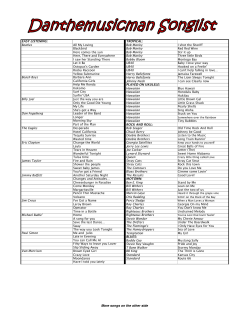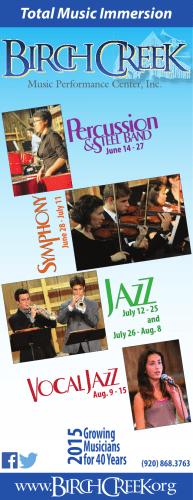
The Jazz Piano Player Jazz chords explained TURE FEA
FEATURE PianoForte24pp 10/7/08 14:51 Page 20 The Jazz Piano Player Jazz chords explained John Kember is a composer, arranger, music teacher and former ABRSM examiner. His many publications range through latin, jazz and pop music to classical and baroque, for a range of instruments and abilities from solo piano to string quartet. He is well known for his imaginative approach to teaching jazz technique, through publications such as The Jazz Piano Player and Jazz Piano Studies (formerly Progressive Jazz Studies). Here he offers some advice for aspiring jazz pianists… I remember the first time I volunteered to play in a band. Considering myself a competent pianist, I was totally lost as the music put in front of me showed no recognisable notation, just a few rhythmic suggestions and the chords to play using just the symbols. Help! To aid aspiring jazz pianists, whether soloists, accompanists or in an ensemble, I therefore came up with the idea for The Jazz Piano Player. Each of these initial two volumes, Stormy Weather and Autumn Leaves include 16 classic jazz standards, presented in two different formats. The first version of each song includes the melody, lyrics and basic chord structure, ideal for improvisation. The second version is a full arrangement for piano solo, suitable for intermediate level pianists. By learning these chords the sounds will become familiar, the chords more readily understood and the shapes will begin to lie more comfortably under the hands. All the songs are in their standard keys, enabling pianists to play with other jazz musicians. Where to start? For a first approach most students – with a basic awareness of chords and arpeggios – will figure out the notes required for a simple 8-chord sequence in C major. C - G - Am - Em - F - C - F - G (etc.) And may well interpret as a series of triads in the right hand, with the bass note in the left – not altogether musical and probably breaking most rules of harmony! But given the advice to move the chord on contrary motion to the movement of the bass line it may become more acceptable: But what the student needs to ‘see’ is the hidden, smooth (stepwise) movement the sequence offers. The sequence may well be recognised now and demonstrates the art and skill required to make musical sense of the symbols. It involves learning to ‘voice’ the chords and to link them as the composer intended, but while offering the player freedom to interpret in their own way – similar to how the figured bass gave independence to the continuo player. The jazz pianist needs to be able to negotiate their way through a sequence of seemingly unrelated chords as smoothly as possible and with minimum movements of upper parts and in doing so find the often chromatic line too. First steps Among the first sequences to master is the sequence of 7ths. These can be found in songs such as: Autumn Leaves This sequence can also be found in the middle 8 of Try to remember (Harvey Schmidt); There’s a small hotel (Richard Rodgers) and All the things you are (Jerome Kern). The diminished 7th is frequently used as part of an ascending or descending chromatic bass line, often between a root and 1st inversion chords. 20 PianoForte24pp 10/7/08 14:51 Page 21 FEATURE Ascending: Stormy Weather The Major 7th. As the name implies the 7th would be played as the 7th in that major key. Therefore Amaj7 would imply a G# but A7 a Gd – best thought of as a dominant 7th in the key of D. Similarly E maj7 would imply a Dd and E 7 a D . 7 7 7 A chord which occurs frequently can cause some confusion but is much easier to interpret than it looks is the minor 7th chord with a flattened 5th. But Bm7 5 is simply Dm/B, Em7 5 = Gm/E and F#m7 5 = Am/F# 7 7 7 The 9th gives added richness and ‘crunch’ to a chord. G9 would generally imply both the 7th and the 9th, and like the 7th can be major of minor – whole tone (or 2nd) above the root, or minor 2nd (semitone) above the root. These can also be indicated as #9 or 9. The addition of the 9th alone makes a good finishing chord. 7 The 11th, used less often and then usually omitting the 3rd of the chord to avoid clashing, makes a useful variation to the final cadence. The 13th is sometimes indicated – and more readily understood – as G76 – the 13th above the root being the same as the 6th. It can also be interpreted as Fmaj7/G by omitting the 3rd and 5th and adding 7th, 9th, 11th and 13th. Which to use depends on choice, phrase and preceding chords. Are you ready to take the ‘Twinkle Test?’ Turn to p12 and test your knowledge and understanding of chords to harmonise ‘Twinkle, Twinkle Little Star’ in C major using the chords provided. Enjoy! The Jazz Piano Player: Autumn Leaves 0-571-53157-1 £12.95 My Funny Valentine (Richard Rodgers): Autumn Leaves (Prevert/Kosma): September Song (Kurt Weill); Try To Remember (Harvey Schmidt): Nice Work If You Can Get It (George Gershwin); I Could Write A Book (Richard Rodgers); I Didn’t Know What Time It Was (Richard Rodgers); Emily (Johnny Mandel): Embraceable You (George Gershwin); Summertime (George Gershwin); Every Time We Say Goodbye (Cole Porter); I Get A Kick Out Of You (Cole Porter); I’ve Got It Bad (Duke Ellington); Come Rain Or Come Shine (Harold Arlen);Ain’t Misbehavin (Fats Waller); Someone To Watch Over Me (George Gershwin) The Jazz Piano Player: Stormy Weather 0-571-53156-3 £12.95 Over The Rainbow (Harold Arlen); My Ship (Kurt Weill); A Foggy Day (George Gershwin); A Small Hotel (Richard Rogers); Just One Of Those Things (Cole Porter); The Shadow Of Your Smile (Johnny Mandel); The Folks Who Live On The Hill (Jerome Kern); Let’s Do It (Cole Porter); I’ve Got You Under My Skin (Cole Porter); Your Love Is Here To Stay (George Gershwin); The Very Thought Of You (Ray Noble); All The Things You Are (Jerome Kern); I’ve Got The World On A String (Harold Arlen); They Can’t Take That Away From Me (George Gershwin); Laura (David Raksin); Stormy Weather (Harold Arlen) 21
© Copyright 2025





















